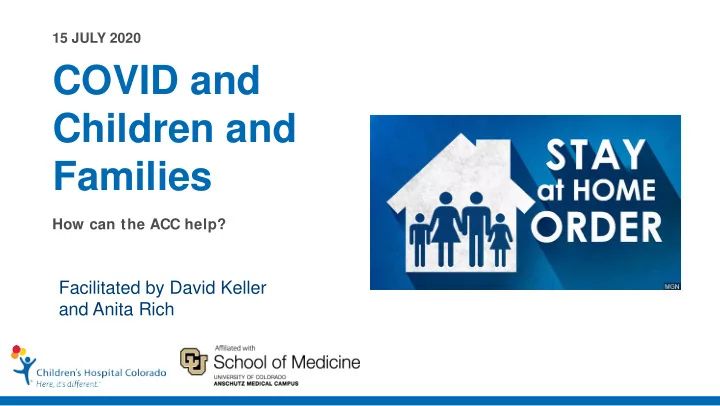

15 JULY 2020 COVID and Children and Families How can the ACC help? Facilitated by David Keller and Anita Rich
Our charge While children have not been as affected clinically as adults, the disruption of normal life rhythms such as school closures, cancellation of summer activities, minimal interaction with social circles, and the delay in routine care, have had a significant impact on children and their families. Moreover, economic disruptions have compromised parents and guardians' abilities to function and provide for their children, including but not limited to providing adequate food. How are communities supporting families given these challenges? How can providers, RAEs, the Department, and their partners develop systems of care that respond to these broader needs? 2
ACC Enrollment by Age 1,400,000 1,200,000 1,000,000 800,000 600,000 400,000 200,000 0 Adults (>20 yrs) Kids (<=20 yrs) 3
Social Determinants of Health • S ocial Determinants of Health: Conditions in the places where people live, learn, work, and play affect a wide range of health risks and outcomes (CDC) • Treat the whole child, including the family and household level conditions Adapted from C Suh, Grand Rounds, 6/5/20 4
What we are hearing: Impact of COVID on child health services Pregnancy and COVID, Race/Ethnicity • Impact on mothers and maternity care • Decrease in visits to child health Latinx providers Asian • Decreased immunizations Black • Delayed access to mental health services (telehealth access White Other • Concerns about domestic violence and child abuse/ neglect • Impact on services for CYS HCN https://www.cdc.gov/coronavirus/2019-ncov/cases- 5 updates/special-populations/pregnancy-data-on-covid-19.html
Covid-19 and Employment US unemployment rate: Feb: 3.5% April: 14.7% May: 13.3% June: 11.1% Colorado unemployment rate: Feb: 2.5% (historically low) April: 11.3% (historically high) May: 10.2% June: ? ? ? Sources: Bureau of Labor Statistics, US Dept. of Labor; CO Dept. of Labor and Employment 6 Adapted from C Suh, Grand Rounds, 6/5/20
How does this translate into daily life? • Households with children compared to households without children are more likely to: • Have at least one adult lose employment income • US : 55% vs. 44% • CO: 48% vs. 42% • Have less confidence in their ability to pay their rent or mortgage in June • US : 31% vs. 18% • CO: 31% vs. 18% • More likely to report sometimes not having enough to eat • US : 12% vs. 8% • CO: 5% vs. 5% Source: US Census Bureau Household Pulse Survey, JUNE 18-23, 2020 7 Adapted from C Suh, Grand Rounds, 6/5/20
Child Health Clinic Psychosocial Screener Data • Feb-May 2020 • 3,471 screeners completed • Percent of positive screens increased 19% from 13% • Reported need on positive screens 39% Help wit h benefit s 35% Unmet financial needs 26% Food 15% Housing • But at the end of the visit, most families gratefully accept a bag of groceries. 8 Adapted from C Suh, Grand Rounds, 6/5/20
School Closures & Re-openings • S chools closed in March 2020; virtual schooling from March-May • Currently planning for 2021S chool districts fully in-person: Academy District 20, Boulder Valley*, Cherry Creek*, Denver, Douglas County, Mapleton, Poudre*, Westminster • S chool districts partially in-person: Jefferson County, S t. Vrain *Tentative “ How Colorado schools plan t o reopen t his fall during t he coronavirus pandemic.” Denver Post . July 1, 2020. 9
Questions for Discussion OVERARCHING QUESTION: What can the ACC do to: • Support COVID-appropriate maternity and post-partum care? • Augment activities to help address overwhelming social needs of children and families (effective linkages!)? • Prepare the system to support day care and school reopenings? • Assure needs access to therapies and home care for CYSHCN? 10
Lake Gilpin, Routt County, July 2020 11
Having the Conversation about Resource Needs • This is an opportunity to connect with families in a different way • Make the conversation as non-stigmatizing and dignified as possible • Equity • Y our non-verbal cues are important • Empathy and compassion— think about t he vulnerability that is present on the family side to have these conversations • Don’ t make any promises • Bring in social work and family navigator team members 12 Adapted from C Suh, Grand Rounds, 6/5/20
Having the Conversation about Resource Needs • Normalize t he conversat ion— It ’s all about how you frame it “ How is t he rest of t he family doing? Are you doing okay at home? I’ m j ust checking in wit h all my families since it ’s pret t y rough t imes right now.” “ I know it ’s really t ough t imes right now. I j ust want t o make sure your family is doing okay.” “ I care about how your family is doing.” “ It ’s import ant t o me/ us t hat we’ re doing our best t o support your family.” If would like resources “ Thanks for sharing t hat wit h me. I’ ve got a great member of my t eam who can t alk t o you about some resources available” If declines resources “ If t hings change, please let us know and we can see what we can do t o support you” 13 Adapted from C Suh, Grand Rounds, 6/5/20
Recommend
More recommend